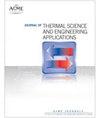热电发电机汽车排气管道中金属泡沫的熵产分析
IF 1.4
4区 工程技术
Q3 ENGINEERING, MECHANICAL
引用次数: 0
摘要
本文用数值方法解决了泡沫铝部分和完全填充外加TEG元件通道对流区二维稳态问题的熵生成分析。数值分析采用局部热平衡(LTE)假设,以模拟金属泡沫和通道内的传热。工作流体是具有与TEG上表面温度相对应的空气相同特性的废气。TEG被认为是一个固体部件,其特点是内部能量产生。热物理性质假定与温度无关。采用Ansys-Fluent程序求解废气、金属泡沫和TEG的控制方程。假设进口段的废气质量流量不同。使用了几种厚度的泡沫铝值。多孔介质的孔隙度为0.90 ~ 0.978,每英寸孔隙数(PPI)分别为5、10、20、40。给出了与热效应和粘性效应有关的全局熵代的结果。各孔隙密度和孔隙度值随排气流量的增加而增加。Bejan数随质量、流量和厚度的增加而减小。随着孔隙度值的增加,其数值也随之增加,而在高质量流量和给定孔隙度条件下,不同孔隙密度值的数值差异不大。本文章由计算机程序翻译,如有差异,请以英文原文为准。
Entropy Generation Analysis on a Metal Foam in an Automotive Exhaust Line with Thermoelectric Generator
In the present paper, an entropy generation analysis on a 2-D steady state problem in convective regime of an aluminum foam partially and totally filled channel with an external TEG element is solved in numerical way. The numerical analyses are accomplished with the assumption of the local thermal equilibrium (LTE) hypothesis in order to model the metal foam and heat transfer inside the channel. The working fluid is exhaust gas characterized by the same properties of the air in correspondence to the TEG upper surface temperature. The TEG is considered as a solid component characterized by an internal energy generation. The thermophysical properties are assumed temperature independent. Ansys-Fluent code is employed in order to resolve the governing equations for exhaust gas, metal foam and TEG. Different exhaust gas mass flow rates on the inlet section are assumed. Several thicknesses of aluminum foam values are employed. The porous media are characterized by a porosity from 0.90 to 0.978 and number of pores per inch (PPI) equal to 5, 10, 20, 40. Results are given in terms of global entropy generations related to the thermal and viscous effects. The total global entropy generation increases with increasing of exhaust gas flow rate for all pore density and porosity values. Bejan number decreases with the increment of mass flow rate and thickness. It increases when the porosity value increases whereas at high mass flow rate and for assigned porosity the values present small difference for different pore density values.
求助全文
通过发布文献求助,成功后即可免费获取论文全文。
去求助
来源期刊

Journal of Thermal Science and Engineering Applications
THERMODYNAMICSENGINEERING, MECHANICAL -ENGINEERING, MECHANICAL
CiteScore
3.60
自引率
9.50%
发文量
120
期刊介绍:
Applications in: Aerospace systems; Gas turbines; Biotechnology; Defense systems; Electronic and photonic equipment; Energy systems; Manufacturing; Refrigeration and air conditioning; Homeland security systems; Micro- and nanoscale devices; Petrochemical processing; Medical systems; Energy efficiency; Sustainability; Solar systems; Combustion systems
 求助内容:
求助内容: 应助结果提醒方式:
应助结果提醒方式:


